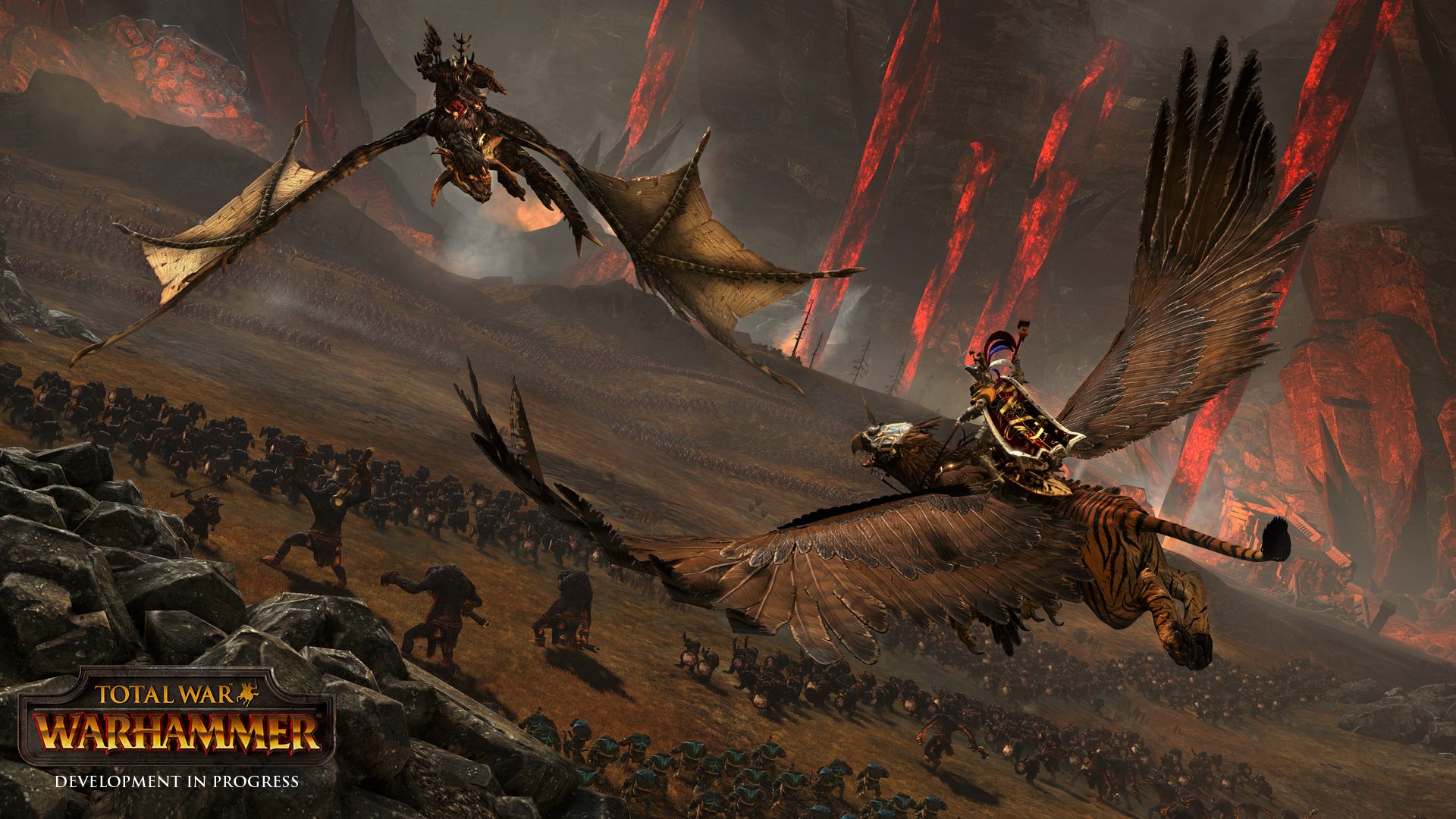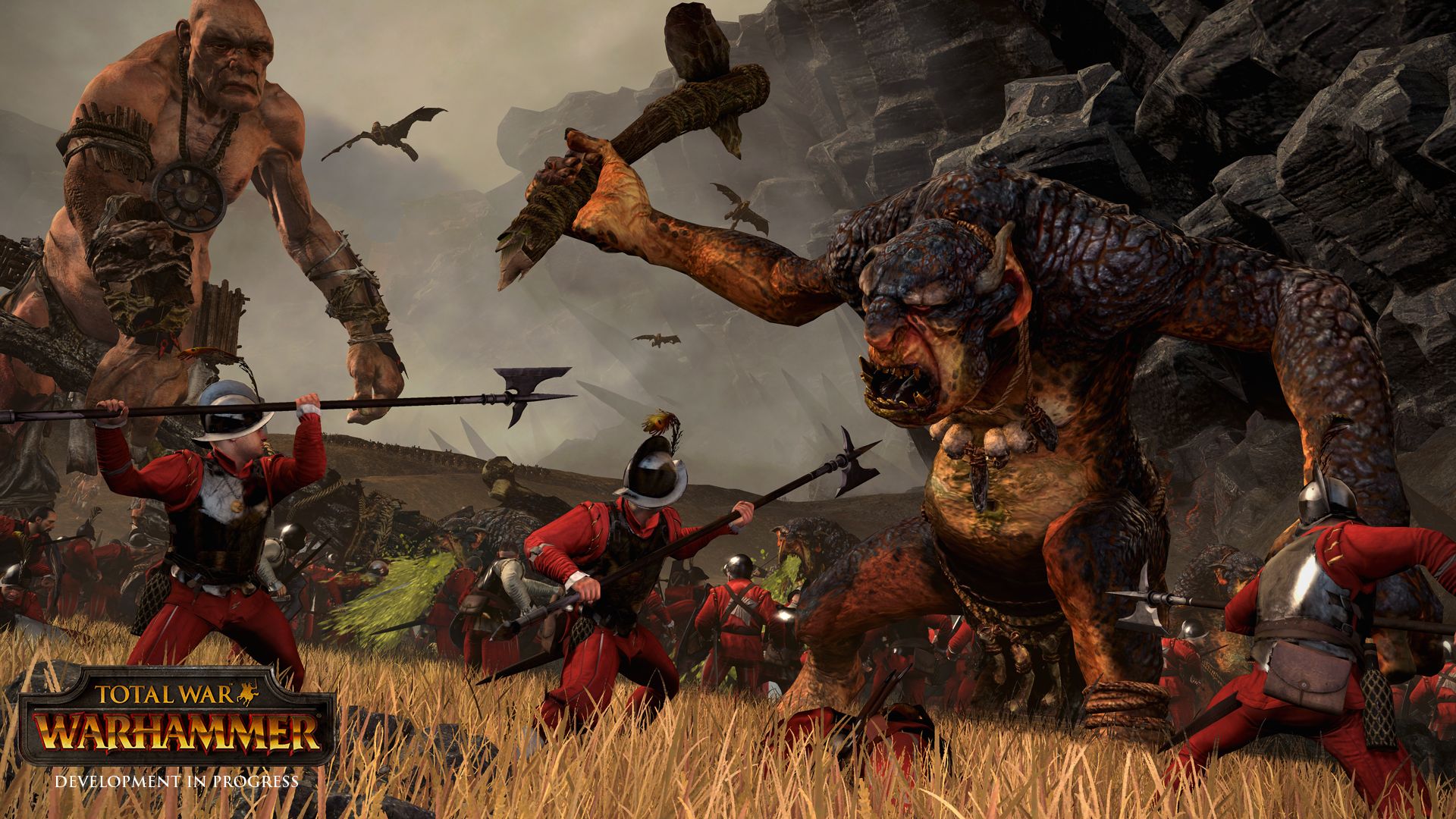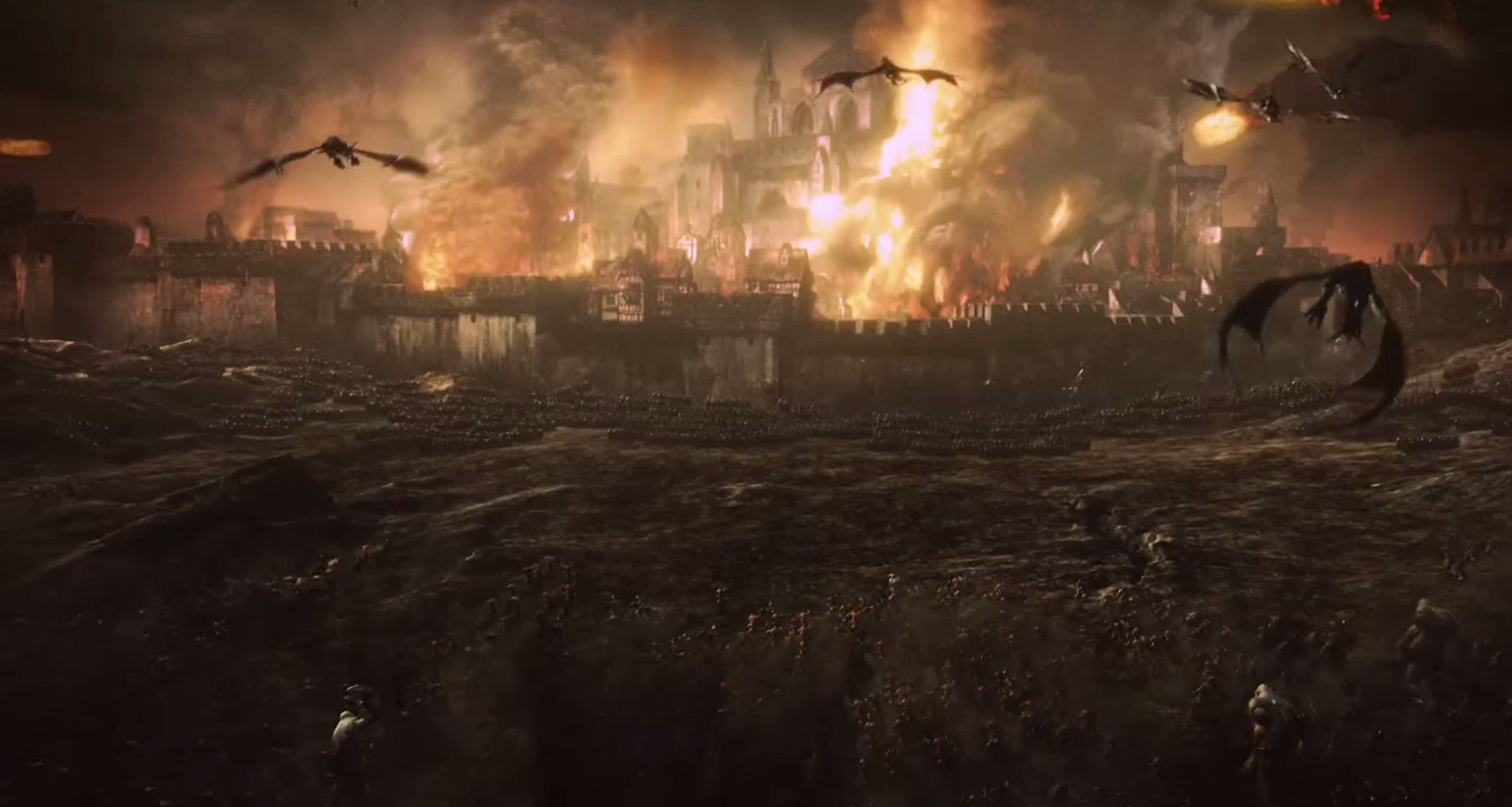Total War: Warhammer - heroes, quests, mounts and magic

The Waaagh, for the Greenskins, is essentially the yobbish spirit of the race. As long as orc Warbosses are fighting battles, they get stronger as a force and individually, and attract more orcs to their cause—but pause from war and they’ll start fighting among themselves. “You’ve got this balance between building up this momentum, keeping the battles going, keeping the boyz excited, or suffering animosity,” Hall explains. In battle this is represented by Warbosses being able to call down a Waaagh, to give all their troops a boost of fighting spirit.
Every faction is differentiated like this. “We’re playing with each of the races like it’s an individual Total War game in its own right,” says Simon Mann, battle designer. “They are so diverse, we want to revel in that.” Similarly, they’ll have diverse tech trees, preventing you from just building an army of giants straight away. “You’ve got various building chains that develop as you go along you’ve also got technology. However, for some races that’s a very shallow part of the experience, for others it’s a very deep part of it.” I’d guess Orcs will be the former, Dwarfs the latter.
Yet more diversity comes in the faction’s reactions to morale. Leadership and routing has always been a huge part of the Warhammer game, fear and terror its bread and butter. Monsters, defeat in combat, spells—anything can make your troops rout. “The Comet of Casandora coming down on your head will make you run away quite quickly,” says Mann. “Of course, different factions react differently. The goblins have got no morale whatsoever, they’re going to break at the first sign of anything dangerous, whereas the Empire Greatswords will really be able to hold the line for you, with a big charge bonus they’re a real tank unit.” And the undead presumably suffer from morale differently—if the tabletop game is followed, I’d predict that instead of running away, they’ll progressively fall apart.
The Comet of Casandora signifies one of Warhammer’s most notable additions to the Total War universe: magic. I see three devastating spells in use in the game. A goblin shaman uses the Little Waaagh to cast ‘Curse of da Bad Moon’ on a squad of Outriders and Pistoliers, summoning a randomly-moving vortex moon that wipes them out. Next I see an orc shaman casting ‘Foot of Gork’, a giant ghostly stamping orc god, which flattens the Empire’s lethal Steamtank and Luminark of Hysh. Finally, I see the Empire’s surviving Celestial Wizard call down in desperation the indiscriminately lethal Comet of Casandora, which wipes the battlefield clean.

Certain areas of the campaign map are more magical than others due to the varied winds of magic sweeping down from the northerly Chaos Wastes. This means that your wizards will go into battle with semirandomised mana pools, which regenerate over the course of the skirmish. This helps balance the wizards, which can be game-winners by themselves at tabletop level, but which are glass cannons here. “Balance is a very important part of what we’re doing,” Roxburgh says. “Yes, casters can do a lot of damage, but at the same time you’ve got to keep them safe.”
“In games like Dark Omen, the wizard was there to counter the fact that you were outnumbered,” says Mann, “whereas in our game they’re more of a support class. On their own, they’ll be isolated and killed. But when they’re in a big army and they’re supporting the main thrust of the tactics you’re using, that’s where their place on the battlefield really comes alive.” The Creative Assembly team still want this to be a Total War battle, where you worry about troop positioning, and they don’t want to lose that through micromanaging magic. “It’s the same as giant or flying creatures,” says Roxburgh “they’re another part of your toybox. We’re going to keep the micromanagement light.”
As they complete quests heroes unlock mounts and items. A Warboss can upgrade from a chariot to a wyvern.
Wizards are represented in the game as Total War agents, alongside other heroes, of which there are three or four different kinds per faction. ‘Lord’ characters can be recruited to command armies. “They have a much deeper skill tree and you’ve got more flexibility to tailor them how you like,” Roxburgh tells me—they can be more melee based or more campaign based.” “There’s no concept of ageing or dying of old age. You’ll have most of them for a long period of the campaign game, so you’ll have more chance to specialise them. This Lord might be all about pillaging and looting, a cash cow if you’re the Greenskins, while this Lord might be focused on melee.” Customisable lords can die in battle.
Keep up to date with the most important stories and the best deals, as picked by the PC Gamer team.
As they complete quests (see below) heroes unlock mounts and items. For example, a Warboss can upgrade from a chariot to a wyvern. Each race also has one or two Generals, legendary heroes of that faction, like Karl Franz or Grimgor. They differ from the other agents in that they can’t die—if these legendary heroes get injured they take a few turns in the wilderness then come back. Other Lords can be recruited to lead your armies when you’ve built up enough momentum in the campaign. And your normal heroes are agents, recruited in the age-old Total War fashion.

A hero’s placement on the campaign map affects their use in battle. “Your agents on the campaign map become your heroes on the battle map,” says Roxburgh. “Attach them to an army, and they come into battle as a single entity unit, like the Warrior Priest.” However, hero abilities will differ from traditional agents—there won’t be any WarriorPriests converting orcs to the worship of Sigmar.
Taking a leaf out of Endless Legend’s playbook, The Creative Assembly has included some of the Warhammer universe’s rich lore in the shape of quests. These enable your legendary characters to unlock unique items, new mounts and upgrades by following narrative in-game chains. “These are a series of missions that culminate in a quest battle,” Roxburgh explains. “It’s a way we can bring story and narrative into the game without breaking that essential sandbox dynamic. Players don’t have to undertake these quests, but if they want to unlock Ghal Maraz or a new mount, this is something they do.”
For example, the Battle of Black Fire Pass I’m watching is the final stage of Karl Franz’s quest chain to unlock the Hammer of Sigmar. (Warhammer nerds will know that the First Battle of Black Fire Pass was where Sigmar defeated Nagash, and that it’s the one place in the World’s Edge Mountains where the orcs can enter the Empire.) When you win these battles through the course of the campaign, you’ll be able to play them like traditional Total War historical battles.
It has to be admitted that Total War and Warhammer are things close to PC Gamer’s heart. Indeed, three of the five developers in the room with me are ex-PC Gamer writers, and all of them are old Warhammer players—like Mark Sutherns, the development manager. “A lot of the guys have come out of the woodwork, with loads of their miniatures. Now we have games, painting sessions at lunchtime. It’s really brought the studio to life...” On this evidence, there’s a good chance that they’ll bring the Old World to life too.

